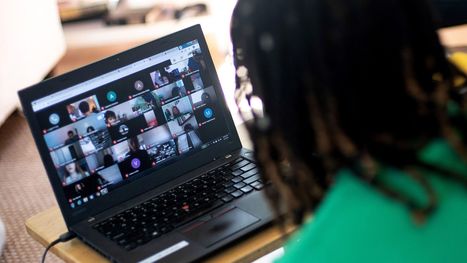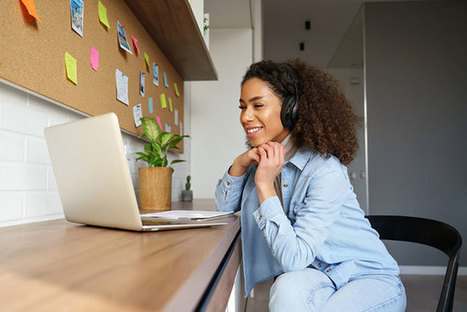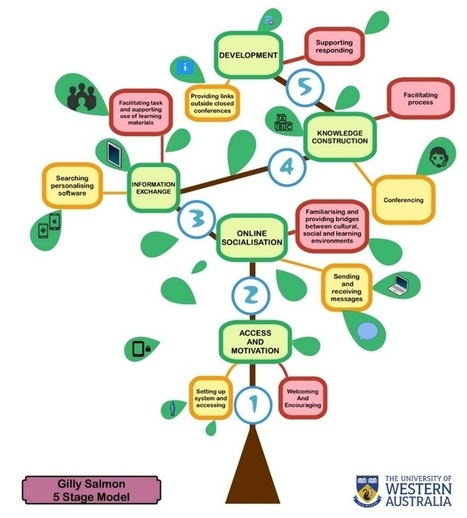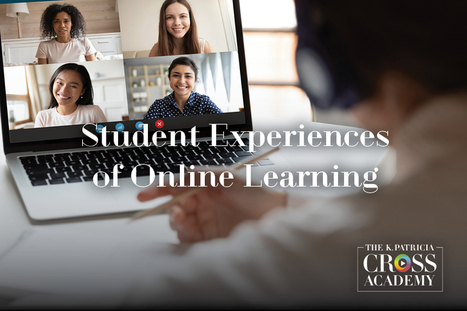The OfS blended learning report presents key strategic guidance for universities. With the momentum gained from the rapid transition to online learning, there is no better time to reimagine the student experience.
Get Started for FREE
Sign up with Facebook Sign up with X
I don't have a Facebook or a X account

 Your new post is loading... Your new post is loading...
 Your new post is loading... Your new post is loading...
Current selected tag: 'online learning'. Clear
Most people know the benefits that come with furthering your education: you become more qualified, you can make more money, you have an edge over other job applicants, you become more knowledgeable in a certain field, and you expand your social and professional network. However, when most people choose to continue their education, they do so in person. The COVID-19 pandemic has forced many people into distance learning. Two years later, more people are going back to school in person, but should you consider online learning over in-person learning? Via EDTECH@UTRGV
Ngoc Ho Nhu's curator insight,
February 10, 2022 11:55 PM
Despite the global pandemic, let’s go digital/ virtual to advance our education!
Before going ahead to the main topic of today, which is the effect of interactive learning content on eLearning, let me start by talking about what the term "interaction" really means. Via EDTECH@UTRGV 
ema gao's curator insight,
July 26, 2021 11:55 PM
When students apply their knowledge in a practical way, interactive learning occurs. Although interactive learning may look different depending on how it is used, this type of pedagogy promotes creativity, focus and provides immediate feedback.
1. The think, pair and share technique is one of the most well-known interactive learning methods. This technique is versatile and can be used in many ways. A teacher will ask students to think about a question or task. Then they each share their thoughts with a partner, before the group shares. Students can share their thoughts with peers in a non-intimidating manner. However, they are not forced to respond to a whole room of students. 2. Take a side This activity is great for discussing controversial topics in my classroom. This activity is also useful for anticipatory activities when you start a new unit. Students are asked to make a statement and then they line up in groups on the opposite sides of the room according to their opinions. This activity can be expanded by adding more statements to influence opinion. You could also allow your children to debate each other. It will get your students moving and allow them to hear the ideas and opinions of their peers. 3. Interactive Notebooks This is a great way for students to learn how to be more present in their note-taking. An interactive notebook requires students to pay attention to every step. You can make templates on your own time if you are a teacher in the higher grades. However, I have seen students as young as 10 and 11 years old really enjoy this "arts & crafts" portion of classes. Interactive notebooks can be used in all subjects, including math, English and science. There is a plethora of information and free templates on the internet, ready for you to use for interactive learning. (https://www.joyusing.com/Document-Camera.html) 4. Online Collaboration Teachers have so many options online to get their students engaged and working together. Google Docs/Slides are a popular tool for students to collaborate on projects. But there are many other tools that you can use, and they are all free! Joyusing(www.joyusing.com) allows students to create videos for class projects. You can enhance what you do in the classroom by researching other media that your students can use to promote interactive learning. 5. My number one piece of advice regarding assessment is to allow your students to choose. Instead of assigning them an essay, offer them the possibility of creating a poster or creating slideshows, giving a speech, and writing that essay. While you can still assign a writing component to the easier options, it allows students to choose what they are best at. While some students prefer structure and being told what to do, others like more freedom and the ability to think for themselves. 
Marco Bertolini's curator insight,
July 27, 2021 6:53 AM
Why is interactive learning content more effective? Here are some indications.
It is often assumed that online collaboration, teamwork and communications is inferior to face-to-face equivalents as we miss the visual cues, facial, body language and so on. His would suggest that collaborative teamwork or meetings may be better with VIDEO ON, as opposed to JUST AUDIO. Yet, this fascinating paper from Tomprou et al. (2021) at Carnegie Mellon, who looked at group ability to solve a range of different problems, found something quite counterintuitive. Visual cues have no effect on collaborative work. In fact, teams without visual presence were more successful, not only in synchronising their vocal cues but also speaking in turns and on solving problems. The authors rightly claim that this calls into doubt the conventional wisdom that you need video support.
User-friendly navigation, videos and ongoing feedback can help instructors take their teaching to the next level.
The primary focus of any instruction should be to focus on the learning outcomes or capabilities you are trying to achieve. Bloom (1956, 1964) identified three types of learning outcomes: cognitive (knowledge), affective (attitudes, emotions, and values), and psychomotor (skills). For each outcome, instructors should also consider the level of outcome they are trying to achieve. So, if you are teaching cognitive skills, such as mathematics or language, you should determine if you need your students to remember (level 1), understand (level 2), apply (level 3), analyze (level 4), evaluate (level 5), or create (level 6) (Krathwohl, 2002). Once you have determined the level(s) of outcome, you should align your assignments to those levels. A multiple-choice exam can assess level 1 and possibly level 2 outcomes, but it will not assess students’ abilities to apply, analyze, evaluate, or create. Consequently, you will need to devise more challenging assignments to elicit higher levels of performance from students, using essays, problem-based learning assignments, and case studies, for example.
It's important to stay up to date with newest online learning trends. Read this article to learn what's new in microlearning and online video teaching. Via EDTECH@UTRGV
Distance learning started as an emergency in the spring, but teachers are finding ways to make it better, even for students working on smartphones. As the new school year looms in the U.S., many teachers are unsure of the exact amount of time they will need to dedicate to remote teaching. With departments of education and districts looking to maintain both teacher and student attendance while minimizing the risk of coronavirus outbreaks in their schools, we know that remote learning isn’t going away at this time.
With careful planning, universities and colleges do not have to sacrifice quality instruction during remote learning.
Although colleges and universities face many unknowns in the upcoming semester, one thing is certain: Online learning is here to stay, regardless of whether your institution is planning to reopen campuses or not.
Whether enrolling in a single online class or a fully virtual program, students need to be prepared for the academic and social learning that compose their educational journey. While some may arrive with years of online learning experience, others will require familiarization with processes, tools, expectations, and the campus community—and all will benefit from an introduction to their new academic community. Orientation experiences support students' transition to the first year of college, which is essential for student success.1 This support is particularly important for those students from historically marginalized populations.2
Video lectures may have worked as a stop-gap measure in the emergency move to online learning, but they just don't cut it for the long term. Here are nine ways to bring distance education courses to the next level. Via EDTECH@UTRGV
Elizabeth E Charles's insight:
Importance of engagement in online learning/teaching and how to achieve it. 
Rebecca Wilson's curator insight,
May 19, 2020 5:23 PM
This article is aimed at teachers who were forced to go online due to the recent COVID-19 pandemic. However, the tips can be applied to any online teaching environment and offer valuable information about how to make classes more engaging and learning more interactive for students. Growth and change equal improvement.
Daniela Ibarra Osorio's curator insight,
May 24, 2020 8:46 PM
It is a very good article that we can keep in mind so that our students can virtually enjoy what they are learning. "For professors who thought that higher education was best delivered in a classroom, the coronavirus pandemic has required a profound paradigm shift." Using these 9 steps we could take advantage of what students really need in a virtual way.
The Covid-19 pandemic has dramatically upended traditional schooling and made remote learning the “new normal.” Teachers are scrambling to offer some form of continuing education using virtual technologies, with the recognition that traditional approaches to curriculum, instruction, assessment, and grading must be altered. While it might be more expedient to present online lessons, electronic worksheets, and resource packets, we propose that the learn-at-home circumstance offers an opportunity to present students with more engaging and meaningful learning experiences. More specifically, we recommend providing students with assignments and tasks that challenge them to find information from various sources, critically appraise what they find, and use what they learn to address interesting issues and genuine problems.
"Whatever one chooses to call it, this method of learning–which combines classroom and online education–is going places and making headlines along the way. While education experts continue to debate the efficacy of hybrid learning, its very existence has challenged them to re-evaluate not just technology’s place in (and out of) the classroom, but also how to reach and teach students more effectively." Via EDTECH@UTRGV |
Compared to the online social experiences that students engage in daily, most class-based discussion forums are ineffective, poorly designed and actively counterproductive. Rather than sparking curiosity and motivation, they’re turning students into head-nodding automatons, like something out of Martin Scorcese’s “Hugo” but without the fantasy elements and sublime visual effects. Via EDTECH@UTRGV
One and a half billon students around the world, according to UNESCO(link is external), were engaged in remote learning at the height of the COVID-19 pandemic in March 2020. Some students were able to access the Internet to do so, but not all. The majority of students around the world, who have access to smartphones, are able to use these as learning devices. Others are more fortunate and have tablets, laptops or desktops. Their instructors, some with no previous experience of teaching online or at a distance, discovered new approaches to teaching and learning and imaginative work was undertaken to overcome the very real challenges this current reality gives rise to. Via EDTECH@UTRGV
The data when effectively used can allow the stakeholders to make and customise personalised decisions based on the need of the learner and help the learner to succeed. Via EDTECH@UTRGV 
Melissa Ledford's curator insight,
July 14, 2021 9:21 PM
The rise of online learning in post-covid times has created a further need to look at the data privacy of users. Many had to learn to navigate online classes very quickly and school systems set up servers hastily in order to keep up with the sudden shift to fully virtual options. Recommended actions to increase user privacy include not publishing contact info or meeting links anywhere, giving parents the option to opt out of any sharing or to delete their child's information and anonymizing user names on the platform.
For online learning to be successful and happy, participants need to be supported through a structured developmental process. The five-stage-model provides a framework or scaffold for a structured and paced programme of e-tivities.
Students spoke candidly about what's working--and what isn't--during online learning in the middle of the COVID-19 pandemic. Via EDTECH@UTRGV
Higher education institutions have been scrambling to meet the demand for remote and online courses. This has been due in part to general growth trends in online enrollment, but it has also been accelerated out of response to the Covid-19 pandemic. Because of this, we have focused on helping faculty teach more effectively online.
The heritage sector has a wealth of knowledge to share with the world. It plays a vital role in enabling people of all ages to learn about and understand the UK’s fascinating and complex history. Whether visiting sites and monuments, exploring stories and exhibitions, or participating in events and activities, your visitors already experience a wealth of education opportunities.
structured activities aimed at groups of learners such as schoolchildren
community learning and engagement, which might involve collaborative practice or ‘crowdsourcing’ resources
self-paced online learning materials
virtual tours and exhibitions
blogging and social media activities, including digital storytelling and quizzes
Online learning provides opportunities to make heritage education accessible to people from all walks of life.
COVID-19 has upended normal social connections that develop between students and professors. We are missing the connections that develop through casual interactions in office hours, pre-class discussions, post-class questions, and any other in-person interaction. These social connections are important for student retention, academic development, diversity, and inclusion. As universities and faculty grapple with the shift to an online education system, and as uncertainties and budget concerns about the fall semester take hold, strategies to maintain student-faculty connections should be a top priority.
"In our increasingly connected world, engaging people in training is a challenge, particularly in a virtual setting. Thankfully, technology is also constantly evolving. Learn to make your content stick with a variety of advanced methodologies that can be mixed, matched and customized to fit your needs." Via EDTECH@UTRGV
Davies Blake's curator insight,
May 28, 2020 1:47 PM
buy stiizy pod
buy smartbuds buy pre rolls 10 thca diamonds free!! facts of white widow Foreverkush.com has a 30% discount going on from 1st till the 15th of April due to the outbreak of corona virus. please stay home place, your orders 
Renato V.'s curator insight,
May 29, 2020 9:09 PM
La revolución en la tecnología nos ha permitido tener una mejor información modernizando la educación determinada, nuevas metodologías que se pueden mesclar, combinar y personalizar.
Before our Friday online teaching class I tweeted out a request for suggestions for the ONE THING that people would send someone if they were moving online for the first time.
The response was amazing. There are so many great educators out there doing good work right now, and so much good work that’s been done that is super useful to the situation we are all in. I have made an attempt to grab some of these links and put a little context around them so that people can skim through them. It’s the least I could do. Many folks delete their tweets nowadays, and looking through a twitter thread can be exhausting. I’m sorry if I missed your tweet. You can just add it to the end of the doc. I’ll check occasionally and sort them.
I got asked by a long time colleague if I was willing to do a post of all the things that I’ve learned in the last eight weeks about moving online. Not ’emergency teaching’ but actual lessons about people moving to teaching with the internet. I’ve worked with over 100 faculty at my own institution this past few months, taking them through a 1 week intensive course. I’ve also been in constant contact with folks from around the world both through my interviews on http://oliah.ca and in endless backchannels and side chats. Here’s what I got.
Elizabeth E Charles's insight:
Thoughtful blog post on issues to be considered when moving to online learning - timely for the new normal.
Is COVID-19 forcing you to move your learning online? Read on for tips that will help you transition from conventional learning to online learning. Via EDTECH@UTRGV |

































